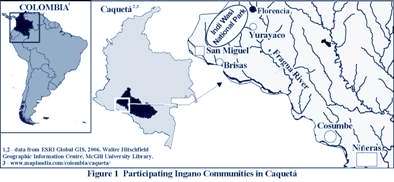INGANO, COLOMBIA
Community Food System Data Tables
Introduction

Several indigenous tribes live in the western Colombian Amazon, a region of exceptionally high biological diversity, who are considered experts in traditional medicine, medicinal plants, and the art of shamanism since pre-conquest times. Among these indigenous tribes are the Ingano Amerinidians living in the state of Caquetá (Figure 1).
Since 1986, the Ingano have been united through the organization known as the “Association of Indigenous Communities (Tandachiridu Inganokuna),” who has written a “Plan de Vida” (“Life Plan”) that proposes innovative solutions to the challenges of cultural preservation and the conservation of their territories and environment.
The Ingano do not recognize divisions between shamanism, health, diet, plants, and nature. Therefore, the project is viewed in an integrated fashion toward the improvement and implementation of their “Life Plan” and toward cultural, environmental, productive, and community health recovery. This case study addresses some of the issues pertaining to:
- the ethnoeducation program of the Yachaicury School, with the indigenous youths who are implementing a traditional food recovery program to improve nutrition and health;
- a biological resource and food supply security program which relies on the indigenous agro-ecological promoters who work toward the recovery of traditional seeds and the development of productive farms.
The interdisciplinary research team formed for the project Nutrición y alimentos tradicionales [Traditional foods and nutrition] started its activities on May the 1st, 2004. The project was developed with the communities belonging to the Asociación de Cabildos Tandachiridu Inganokuna [Tandachiridu Inganokuna Indigenous Cabildos Association]. Participating communities include Yurayaco, Brisas, San Miguel, Niñeras and Cosumbe, all in the state of Caquetá. A collaboration letter was signed at the beginning of the project by the participating communities with which the group had established a previous relationship. The participation of each member was subsequently established, presented and discussed.
The study team was comprised of the following:
Team members:
Camilo Correal
Germán Zuluaga
Liliana Madrigal
Sonia Caicedo
Antonia Mutumbajoy
Lida Garces
Diva Devia
Eva Yela Bernarda
Deisy Burgos
Participating institutions:
Center for Indigenous Peoples’ Nutrition and Environment (CINE)
Amazon Conservation Team / Instituto de Etnobiología
Asociación de cabildos Tandachiridu Inganokuna
Notes on food groups
The traditional system of resource management entails swidden agriculture (primarily based on manioc, corn and several varieties of fruit trees), hunting, fishing, and harvesting of wild forest products. The main crops of Caquetá are rice, beans, corn, soy, cocoa, cocona, chontaduro, lulo, mandarin oranges, African oil palm, pineapple, manioc, banana and sugarcane. The acre yield for all these crops is relatively low in addition to low milk and meat production.
The data presented in the food tables do not represent absolute values. The purpose of this publication is to present a true reflection of the usual composition of foods available and/or consumed by Ingano. This is a living document and nutrient information will be added and/or updated when available.
One hundred and sixty different foods were identified and are divided into eight groups. The nutrient information of only a few foods, under groups displayed in bold, is available here for your information:
- Vegetables, tubers, trees and herbs
- Fruits
- Animals
- Fish
- Birds
- Insects
- Drinks
- Miscellaneous
Seasonality of use, harvest information, type of procurement and other relevant information were collected through household and key informant interviews.
Notes on food components
Food samples were gathered at San Miguel del Fragua at a height of 540 meters above sea level by Fabio Quevedo in February 2005 as per specifications, and only eight samples were analysed at Laboratorio de Nutrición, Departmento de Ciencias de la Produccion Animal, Facultad de Medicina Veterinaria Yde Zootecnia, Universidad Nacional de Colombia 2005.
There are approximately 9 components in the main body of the tables, which are presented in a fixed format for each record.
References
- Tabla de Composición de Alimentos Colombianos ICBF. 2000
- http://www.colciencias.gov.co/seiaal/congreso/Ponen4/CABRERA_SOTOMAYOR.html
- http://www.paisrural.org/molino/doce/disfruta.htm
- http://www.hormigasculonas.com/ficha.htm